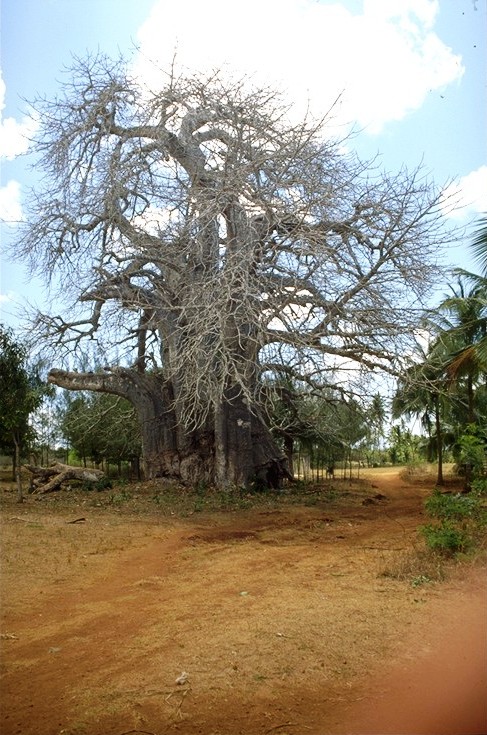Tree
This is about the original, biological meaning of tree. For other meanings of the word "tree" see tree (graph theory) and tree data structure.
 |
| Baobab tree in South-Africa |
A tree is defined as a perennial plant consisting of one or more large woody stems. The component parts of a tree are the roots, trunk(s), branches, twigs and leaves. A small group of trees growing together is called a grove or coppice, and a large population of mixed tree species is called a forest. In some religions, such as Hinduism, trees are said to be the homes of tree spirits.
Tree stems consist mainly of transport tissues (xylem and phloem). In fact, wood consists of xylem cells, and the bark is primarily made of phloem. As the tree grows it creates annual grow rings, which can be counted to determine the age of the tree, and used to date timber that has been cut from trees in the past using the science of dendrochronology.
The roots of a tree are generally embedded in earth and absorb water and nutrients from the surrounding soil. Above ground, the trunk gives height to the leaf-bearing branches to aid in their competition with other trees for sunlight. In many tree species, the branches spread so as to present the largest possible leaf surface area to the sun.
A tree may not have all the organs mentioned here: most palms do not have branches, the saguaro of North America has no functional leaves, and tree ferns do not have bark. Based on their rough shape and size, all these are nonetheless considered trees.
Some types of tree can grow to over 100 meters tall and/or live for several millennia if circumstances are optimal. A plant that is similar to trees, but generally having smaller, multiple trunks, is often called a shrub, although boundary between the two categories is not precise.
Several biotopes are defined largely by the trees that inhabit them, for example, the rainforest and the taiga.
Trees often serve as important symbols in mythologies and religions. Examples are Yggdrasil in the Norse Mythology, the Christmas Tree that is derived from Germanic mythology, the Tree of Knowledge of Judaism and Christianity, and the Bodhi tree in Buddhism.
Trees show a wide variety of leaf types and shapes, bark, flowers, fruit, etc. Trees occur in several diverse families of plants. The earliest trees were probably tree ferns, which once grew in vast forests. Later the conifers, ginkgos and cycads appeared (modern cycads no longer appear as trees). Most species of trees today are flowering plants, which were the most recent to appear. The list below gives some examples of well known trees and how they are typically classified.
Flowering plants (Magnoliophyta)
- Aceraceae family
- Aquifoliaceae family
- Common Holly, Ilex aquifolium
- Tarajo Holly, Ilex latifolia
- Betulaceae family
- Fagaceae family
- Fouquieriaceae family
- Boojum, Fouquieria columnaris
- Juglandaceae family
- Leguminosae family
- Honey Locust (Gleditsia triacanthos)
- Pau Brasil, Brazilwood, South American Redwood, Caesalpinia echinata
- Sappanwood, East Indian Redwood, Caesalpinia sappan
- Meliaceae family (Mahogany family)
- Myristicaceae family
- Nutmeg, Mysristica fragrans
- Myrtaceae family
- Silver Gum, Eucalyptus cordata
- Oleaceae family
- Olive, Olea europaea
- Palmae family, also called Palmaceae or Arecaceae, the palm family
- Rhizophoraceae, the mangrove family
- Red Mangrove, Rhizophora mangle
- Rosaceae family
- Rubiaceae family
- coffee, Coffea arabica
- coffee, Coffea robusta
- Rutaceae family
- Lime, Citrus aurantiifolia
- Sour Orange, Citrus aurantium, Citrus bigaradia, Citrus vulgaris
- Sweet Orange, Citrus sinensis
- Grapefruit, Citrus paradisi
- Mandarin, also called Tangerine, Citrus reticulata, Citrus nobilis
- Lemon, Citrus limon, Citrus limonum
- Satsuma, Citrus unshiu, Citrus reticulata, Citrus nobilis
- Salicaceae family
- Aspen, Populus tremula
- Sapotaceae family
- Tambalacoque, or dodo tree, Sideroxylon grandiflorum, previously Calvaria major
- Sterculiaceae family
- Tiliaceae family. The Lime trees in this family are also known as Linden trees: see Tilia.
- American Lime, Tilia americana
- Common Lime, Tilia europaea
- Mongolian Lime, Tilia mongolica
- Silver Lime, Tilia tomentosa, Tilia argentea
Conifers
- Cupressaceae family
- Alerce or Patagonian cypress, Fitzroya cupressoides
- Eastern redcedar, Juniperus virginiana
- Pinaceae family
- Norway spruce, Picea abies
- European larch, Larix decidua
- Stone pine, Pinus pinea
- Monterey pine, Pinus Radiata
- White pine, Pinus strobus
- Scots Pine, Pinus sylvestris
- Douglas-fir, Pseudotsuga menziesii
- Bigcone Douglas-fir, Pseudotsuga macrocarpa
- Taxodiaceae family
- Japanese Cedar, Cryptomeria japonica
- California Coast redwood, Sequoia sempervirens
- Giant sequoia or Giant redwood, Sequoiadendron giganteum
- Chinese Dawn redwood, Metasequoia glyptostroboides
- Baldcypress, Taxodium distichum, Taxodium ascendens, Taxodium mucronatum
Ginkgos
- Ginkgoaceae family
- Ginkgo, Ginkgo biloba
Ferns
- Cyatheaceae and Dicksoniaceae families
- Tree ferns, Cyathea, Alsophila, Dicksonia
